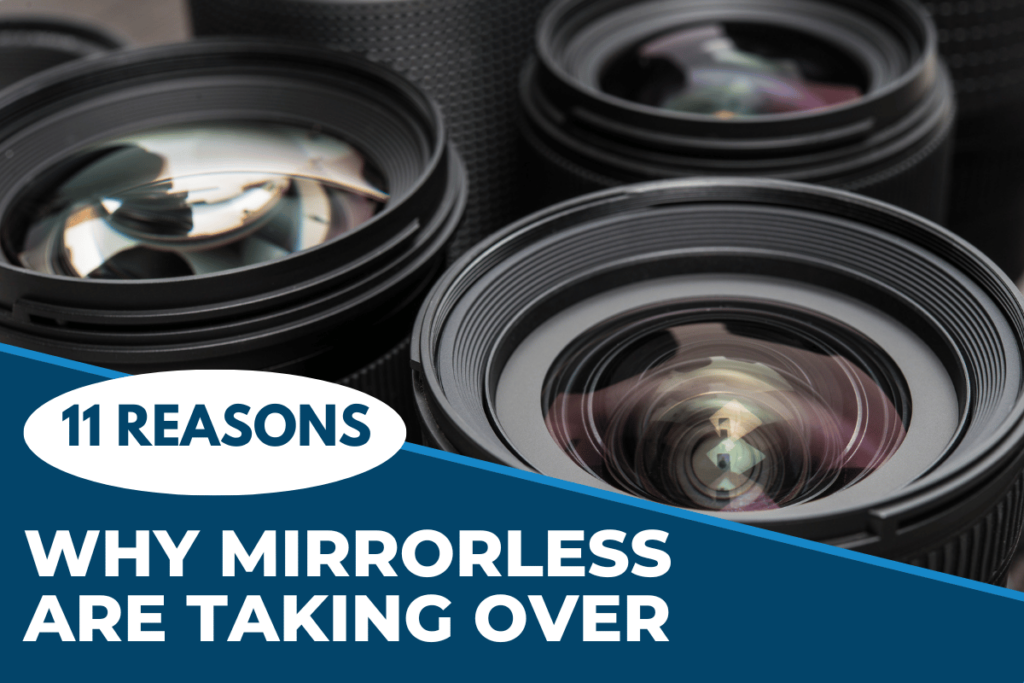
In recent years, photography has seen a big change. This is because of the arrival of mirrorless cameras. But why are mirrorless cameras taking over? In this post, we will look at the 11 key reasons. They explain the growing popularity of mirrorless cameras.
1. Size and Weight
Mirrorless cameras ditch the bulky mirror system found in DSLRs. This makes them significantly lighter. Without that mirror-box mechanism. Manufacturers can also shave off some of the camera body’s depth. This makes a slimmer profile that’s easier to handle.
Think about the DSLR giants, such as the Canon EOS 5D Mark IV. It’s built like a tank. While its sturdiness is great, it weighs a hefty 800 grams. Now, consider the Canon EOS R. It is the mirrorless sibling. It only weighs about 580 grams. There’s no denying it, a weight difference like that can be a dealbreaker when you’re packing light.
Weight Convenience:
- Easier on your body: Long shoots become less of a physical burden.
- Mobility: Moving quickly with less weight means getting the shot more often.
- Travel-friendly: Packing for a trip? Every ounce counts.
2. Compactness and Speed
Mirrorless cameras excel at capturing fast scenes. They do this thanks to their compact build and speed.
Mirrorless cameras have a faster, quieter shutter. They are faster and quieter than the shutters of DSLR cameras. Not having a flipping mirror makes a big difference. It means less noise to startle your subject or disrupt the ambiance. This stealth is a game-changer. It’s for wildlife photographers or anyone needing to blend in.
Ever missed a photo because your camera wasn’t quick enough? That’s rarely a concern with mirrorless cameras. They offer higher burst rates, enabling you to take more photos in less time. This is especially useful when you’re trying to capture a hard-to-get expression or the peak of action.
3. Advances in Lens
Let’s talk glass—lens glass, that is. The lens tech in mirrorless cameras isn’t just catching up; it’s paving the way. With each new release, the lenses are getting more performance from these cameras. They are squeezing out every drop. This leap forward isn’t just a fluke—it’s a photonic revolution.
For starters, enjoy crisper, clearer shots, no matter your expertise. Mirrorless camera lenses have better light transmission and fewer aberrations. They are giving pros and hobbyists alike shots to brag about.
When mirrorless cameras hit the scene, some naysayers noted the lack of lens options. Fast forward to now, and the tables have turned. You’ve got prime lenses for sharpness lovers. Zoom lenses for convenience. Wide-angle for grand landscapes. And macro for tiny details that make you lean in. Fancy capturing the action far away? Telephoto lenses have got your back.
These aren’t just any lenses. They’re made for the small form of mirrorless bodies. This makes them lighter and often sharper. It’s thanks to the short flange distance.
4. Image Quality
Let’s talk about sensor size. This is the heart of your camera, capturing all the light and detail. Larger sensors generally mean better image quality because they can grab more information. Most mirrorless cameras now have sensors. They are just as good as those in DSLRs. With options ranging from Micro Four Thirds to full-frame, you’ve got your pick of the litter.
Resolution is the buzzword in camera specs, More megapixels translate to more detail. Mirrorless cameras are keeping up with, and sometimes surpassing, DSLRs. You’re looking at resolutions above 20 megapixels. They deliver stunning detail that holds up when you crop them.
Now let’s dive into dynamic range. It’s all about the shades between absolute black and pure white your camera can capture. Cameras with better dynamic range can handle high contrast scenes well. They ensure your highlights and shadows keep their detail. Mirrorless cameras often match or beat the dynamic range of DSLRs. So, they work well for scenes with tricky lighting. Handled like a pro.
5. Autofocus
When you’re out there capturing moments, the last thing you want is a blurred image. That’s where autofocus (AF) steps in.
Mirrorless cameras detect contrast and phase differences in the image. They use this data to quickly adjust the lens and bring your subject into focus. This nifty feature means you no longer have to tediously twist the focus ring, hoping to get a clear shot.
Mirrorless cameras are upping the ante with their autofocus systems. They’re not only faster but also more accurate than their DSLR counterparts.
Mirrorless Camera Focusing Flashpoints:
- Speed: They’re very fast. This makes them perfect for sports and wildlife photography. In these types of photography, every millisecond counts.
- Precision: The autofocus on mirrorless models is very precise. This is thanks to cutting-edge algorithms that guide the focus mechanism.
Consider this: Some top mirrorless cameras offer AF points across almost the whole frame. This greatly increases the odds of nailing focus on moving targets.
6. Stabilization
When you’re out capturing life’s moments, camera shake can be the villain. It turns a perfect shot into a blurry memory. That’s where stabilization swoops in to save the day.
Built-in Stabilization
You might have heard of IBIS – that’s In-Body Image Stabilization for the initiated. Many mirrorless cameras come decked out with this feature, and it’s a game-changer. Here’s why: IBIS works by moving the camera’s sensor to counteract unintended motion.
In addition to IBIS, some mirrorless cameras team up with lens-based stabilization systems. This pair of features means the lens has its own stabilizer. It goes well with the camera’s built-in stabilizer.
7. Video Performance
Mirrorless cameras are hitting the market with some jaw-dropping video resolutions. It’s not just about 1080p anymore—4K is the buzzword. And the best part? You get cinema-quality detail in a device. It won’t weigh you down like traditional DSLRs.
But resolution isn’t the only thing to geek out about. Frame rates are soaring with mirrorless models. They offer silky-smooth slow-motion effects. These can make even a snail’s race look thrilling. High frame rates can capture all the action without a glitch. They make sure each freeze-frame is as clear as the moment you lived.
Don’t overlook bitrate and codec—these two are behind-the-scenes heroes. A higher bitrate means more data is stored. This means better video quality with more detail and fewer compression artifacts. And codecs? They’re responsible for your storage not crying out for mercy. Efficiency is key. Mirrorless cameras use the latest codecs. They keep file sizes small without skimping on quality.
8. Ease of Use
They’re not just taking over due to their size or picture quality. It’s the user-friendly nature that seals the deal.
Imagine a camera that feels like an extension of your hand. It has buttons and dials right where you need them. That’s the ergonomic bliss mirrorless cameras offer.
Most models have customizable buttons and touchscreens. They let you craft a user experience that suits your style. The big advantage here is that you tailor your device to your needs. This means more seamless photo sessions.
Need a menu that makes sense to you? Rearrange it. The beauty of mirrorless cameras lies in their flexibility. They often include:
- Touchscreen interfaces, making settings adjustment just a tap away.
- Simplified menus that cut the clutter, prioritizing the functions you use most.
- Dials and buttons that can be programmed to your most-used settings or styles.
What’s better? This customization isn’t just for comfort. It also speeds up your work. So, you’ll capture great images or videos faster and with less hassle.
9. Cost
There was a time when the idea of owning a full-frame camera was reserved for pros with deep pockets. Now, prepare to be wowed. Prices have dropped a lot. This puts these bad boys in the running with smartphones. They are now the casual photographer’s tool of choice.
For a mere $1,000, you can snag a shiny new mirrorless model. This applies to new models too. They also hit shelves with high prices. Plus, the high-end mirrorless cameras? Now, they are in the same financial playground as their DSLR counterparts. They may even play for less.
- Early mirrorless bodies: They were once a hefty investment. But, prices have plunged for these pioneers in mirrorless tech. This has invited a new crowd to enjoy their benefits.
- Comparative value: Now, high-end mirrorless models match or beat the prices of traditional DSLRs. They also often offer better features.
10. Consumer Demand
They burst onto the scene with space-age tech and sleek designs. They quickly caught your eye. Sales and satisfaction rates have shot up. This is because mirrorless models outperform their older, mirrored cousins. But don’t just take it from the stats; online reviews and ratings tell a tale of pure infatuation.
Why? It’s simple: they fit into your life like the missing piece of a puzzle. You’ve been craving high-res videos. You want easy controls and the ability to snap a masterpiece. And all without a bulky camera. Mirrorless cameras answered your call with gusto. Every online review raves about the feather-like weight and the eye-popping image quality. But, there’s a ripple effect.
11. More creative options and features
Mirrorless cameras have more creative options and features. They open a world of fun and deep possibilities.
Mirrorless cameras bring you an array of built-in filters and effects:
- Monochrome: Dive into the drama of black and white photography without post-processing.
- Retro: Give your images a vintage look with just a click. Hello, nostalgia!
- Artistic: Unleash your inner artist with effects that mimic watercolors or oil paintings.
Ever get tired of the same old shooting modes? Mirrorless cameras come armed with specialized modes that challenge the status quo. You’ve got:
- Silent mode: Stealthily snap photos without a peep. Perfect for wildlife or on-set photography.
- Multiple exposure: Overlay images right in the camera for that artistic blend.
- High-speed sync: Freeze those fast-action moments with precision.
Conclusion
The reasons why mirrorless cameras are taking over are clear. They mix small size with strong performance. They combine advanced sensors with creative features. They appeal to both pros and hobbyists with their versatility.
They are still evolving. This promises even greater advancements. It ensures that the future of photography stays bright and without limit.
Frequently Asked Questions
What video resolutions do mirrorless cameras typically offer?
Most mirrorless cameras offer high video resolutions, including 4K, which provides superior image clarity and detail for videography.
How do frame rates affect video performance in mirrorless cameras?
Higher frame rates in mirrorless cameras enable smooth slow-motion effects, enhancing the quality and creativity of video projects.
Why are bitrate and codec important for video quality?
Bitrate and codec are crucial for achieving better video quality as they determine the amount of data and the format used to compress and store the video, influencing both quality and file size.
What user-friendly features do mirrorless cameras have?
Mirrorless cameras boast intuitive controls, customization options, and real-time feedback through the electronic viewfinder, making them user-friendly and efficient.
How do creative features in mirrorless cameras enhance photography?
Built-in filters, specialized shooting modes, touchscreen LCDs, and the clarity of electronic viewfinders allow photographers to experiment with artistic effects and receive immediate feedback, enriching the photography experience.

